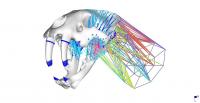
Imaging shows the Smilodon bite had a narrow jaw which restricted its killing behavior. In public imagination, the sabre-toothed cat Smilodon ranks alongside Tyrannosaurus rex as the ultimate killing machine. Powerfully built, with upper canines like knives, Smilodon was a fearsome predator of Ice-Age America's lost giants.
For more than 150 years, scientists have debated how this iconic predator used its ferocious fangs to kill its prey. Now a new Australian study, published today in the US Proceedings of the National Academy of Science, hopes to lay the arguments to rest. And the results will put in dent in Smilodon's reputation.
Scientists from the University of New South Wales and University of Newcastle have used a computer-based technique called Finite Element Analysis (FEA) to test the bite force and feeding mechanics of the fearsome predator.
FEA, normally used in the analysis of trains, planes and cars, allowed the team to "reverse engineer" designs to find out what sort of forces a structure like a sabrecat skull was able to handle.
"Skulls are much more complex then most man-made structures, and to apply the technique to a fossil big cat required some tricks engineers usually have to handle," says the University of Newcastle's Colin McHenry, lead author on the paper.
"Historically there have been a number of interpretations about how Smilodon killed," says UNSW palaeontologist Dr Steve Wroe. "Early researchers thought it had a weak bite. More recently, people have suggested that the bite was strong."
Using the skull of a modern-day lion for comparison, the team determined that Smilodon had a relatively weak bite - about one third as powerful as a lion of similar size. "For all its reputation, Smilodon had a wimpy bite" says Dr Wroe. "It bit like a moggy."
In a range of "digital crash-tests", the team found that under most conditions, the sabre-tooth skull performed very poorly compared to that of the lion. This would have seriously limited the big toothed fossil cat cat to a very specific range of killing behaviours.
Although its bite was weak, this is not to imply Smilodon was not was a formidable predator. "Anything but," says Dr Wroe. "Smilodon was an awesome beast -- and what it lacked in bite force it more than made up for elsewhere."
"The sabrecat had an immensely powerful body; perfect for wrestling large prey to the ground, and our models show that it needed to do this before trying a bite, "explains Mr McHenry. "Killing was more likely applied to the prey's throat, because it is easier to restrain the prey this way. Once the bite was done the prey would have died almost instantly."
Dr Wroe describes the lion as a "better all rounder" in the hunting stakes. Smilodon was massively over-engineered for the purposes of taking small prey, but a ruthlessly efficient hunter of big game."
The team is now applying their techniques to inform medical research involving dentists, surgeons and safety scientists.
Source : University of New South Wales
 Print Article
Print Article Mail to a Friend
Mail to a Friend
